V-RAY 3.0 LAB NOTES:
Topics To Cover:
- Layout and Icons
- Settings
- Lights
- Materials
Hello Everyone, welcome to V-Ray NEXT!
Below is everything you will need to know to start creating rendered images from Rhino using V-Ray.
Getting Started:
- To start, create a simple Box by typing “box” in the Rhino command line. This is a sample geometry, so it can be whatever you would like.
- Make a new layer in Rhino and call it “Box” and move the box to this layer.
- Next, make sure that V-Ray is installed and visible on the top menu bar as shown below. If V-Ray is not currently in the top bar but you are certain that it is installed, in Rhino click on Render -> Current Renderer and select V-Ray for Rhino. V-Ray should then appear in the top bar menu.
- Next navigate to V-Ray->V-Ray Objects->Infinite Plane to create an Infinite Plane in your Scene. This will create a ground where your box can cast shadows.
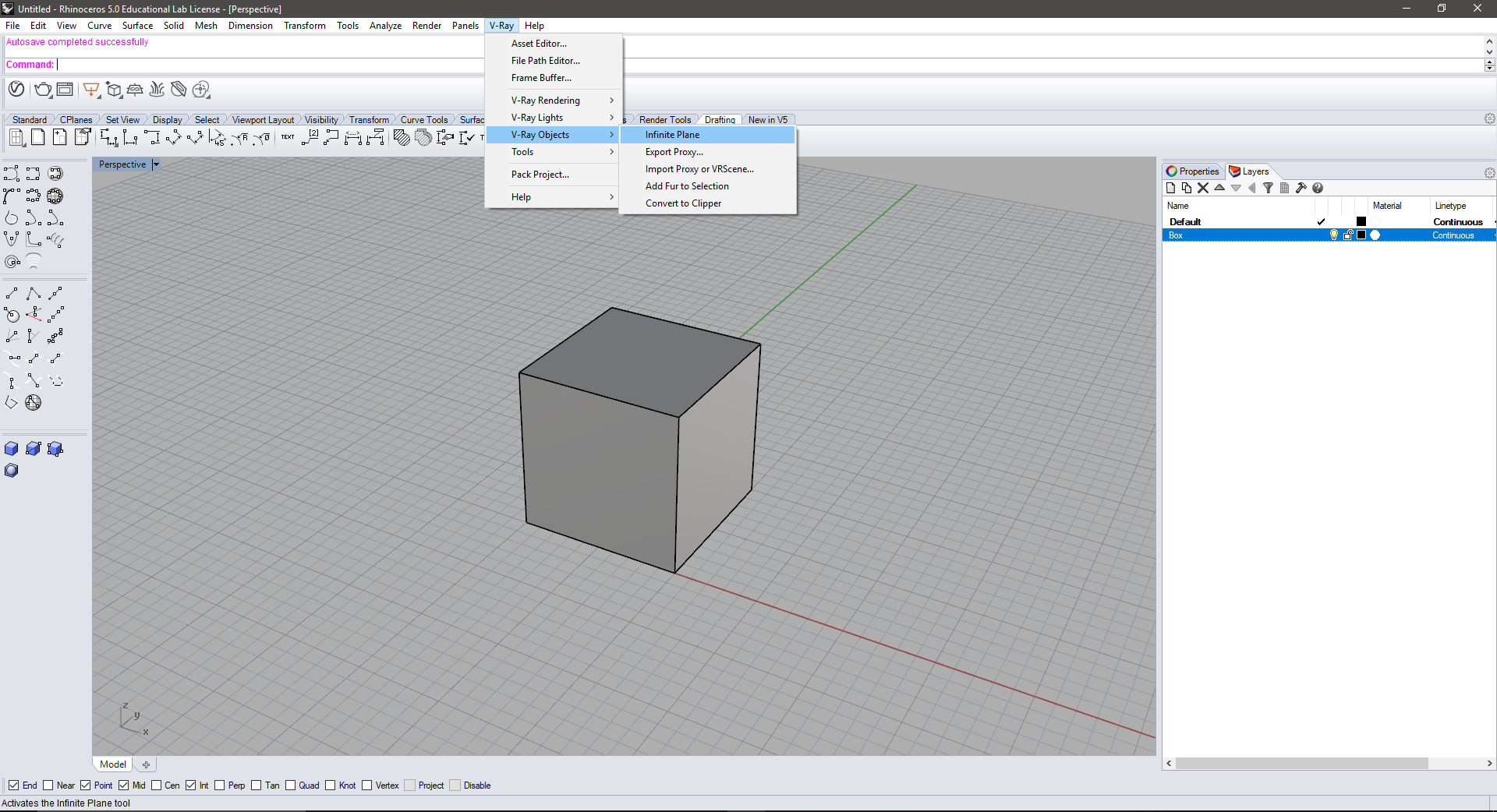
- Create a new layer titled “Infinite Plane” and move the plane to this layer. I would suggest locking this layer for now to keep from accidentally editing the plane while working on other parts of the model.
———————————————————————————–
V-Ray 3.0 Menu Basics
- V-Ray 3.0 has a new, easy to navigate menu where you can control the settings of your model and rendered image. This menu can be broken down into six sub-menus:
-
- Materials
- Lights
- Geometry
- Render Elements
- Texture
- Settings
- To navigate to this menu, go to V-Ray in the top menu, and click on the Asset Editor. The Asset Editor is the main window to control V-Ray.
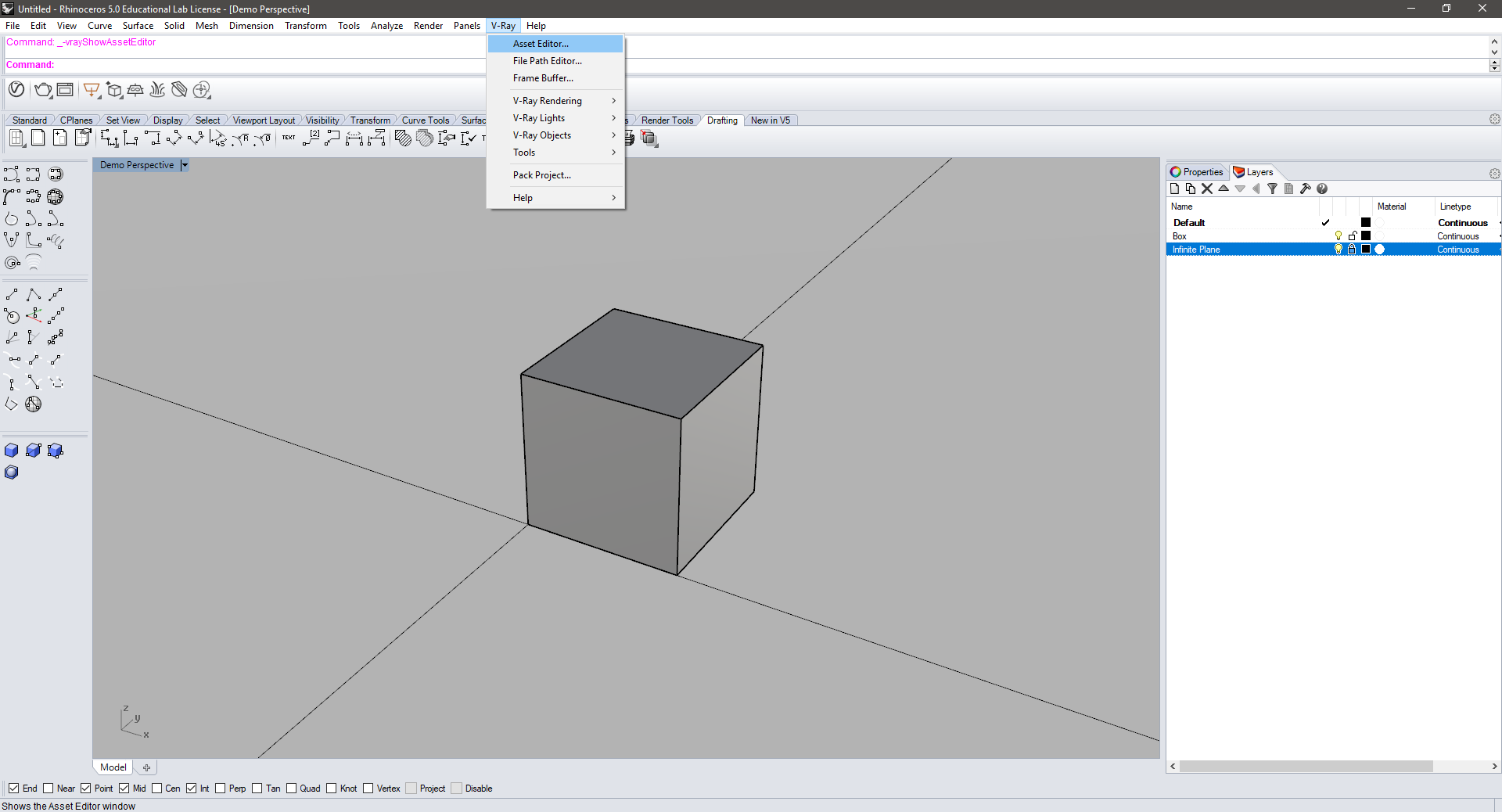
- The Asset Editor menu can also be expanded by clicking on the small arrow on the right side of the Asset Editor window. This will show more options for the different sub-menus which add more control.
-
- The left arrow will take you to the expanded material panel where you can specify custom materials, or use V-ray preset material library.
-
- The right arrow will expand additional setting of the sub-menus. Each of the sub-menu will have a different set of additional setting.
- We will get into more detail about the sub-menus but first, there are two other icons on the V-Ray window, Render with V-Ray(the Teapot) and Open V-Ray Frame Buffer.
- Click on the Open V-Ray Frame Buffer and another window should open up next to the asset editor. This window is the Frame Buffer or the window where your render will appear.

- Click the Render with V-Ray button (the teapot) and you should see a very bright scene with a very faint trace of the box.Note: This means that V-ray camera setting is set to take in too much light and no material has been applied to the object, which causes V-ray to assume full light reflectance, hence the blown out image. We will trouble shoot this next.

———————————————————————————–
V-Ray 3.0 Menu: Settings
- In the Asset Editor Menu, click on the Settings icon (the gear). In this sub-menu you should see 7 different options:
- First, let’s click on the down arrow to open up more settings under the Renderer tab.

- Engine: This allows you to choose your CPU, or GPU (CUDA + RTX) to render the image. The default is to use the CPU and you can keep this setting unless you know more about how computers work to render images in which case you might be more comfortable running both. If you are rendering off of a laptop, using the CPU is most likely your best option.
- Interactive: When this is active, you are able to move your view in Rhino and the Frame Buffer will update with it. CAUTION: this will put a huge strain on your computer as it will constantly try to render every view until you come to a stop so be careful using this feature. The default is to have Interactive off, and you should mostly keep it this way.
- Progressive: This is a new addition to V-Ray which incorporates a new way of rendering images, for now, keep this on. Basically it helps to improve the speed of your render.
- Quality: This switch controls the overall quality of the render. Pushing it higher puts a heavier burden on your computer while decreasing the quality (draft) can be quick when you are just testing an idea, lighting or need a basic render.
- Update Effects: Controls how often during the render process the after render applied effect (e.g. light bloom, level…etc) is going to be updated. Set it to “At the end” if you are not watching the render to finish.
- Denoiser: This switch adds additional help for removing noise/grain from the render. It does add strain (slow + heat) on your computer. For a test render there is no need to use it.
- After changing the Quality and Denoiser switch, the quality of the image is improved. Notice that you can only see a very faint trace of your box (or completely white).

- Next let’s look at the Camera tab.

- There are some Advanced Settings which you can access by expanding the right arrow and go to Advance Camera Parameter.

- Two key settings we will focus on are the Shutter Speed slider and ISO under Camera.
- Shutter Speed controls how much light is allowed into the camera, the higher the number, the less light is captured in the image. To test this, change the value from 100 to 300 and render the image to see the difference. You should begin to see more definition of the box and the image is no longer blown out. But the image looks unaturally dark as if a dark veil is casted on top.

- ISO controls the film’s sensitivity. The highter the number, the brighter the image. For most case of rendering blown out in white ISO is often set too high. Here the ISO is set to 550 and shutter speed is adjusted to 150 to produce a neutral image with sufficient detail without appearing too dark.

- You will also notice that there is F number, which controls the depth of field and lens speed. Smaller F number means shallow depth of field and more light which can be useful for detail rendering or renderings that attempt to replicate the model look. Normal human vision can not see every single details, so a render with blurred background (shallow depth) can enhance the realism of the image.
- Shutter Speed controls how much light is allowed into the camera, the higher the number, the less light is captured in the image. To test this, change the value from 100 to 300 and render the image to see the difference. You should begin to see more definition of the box and the image is no longer blown out. But the image looks unaturally dark as if a dark veil is casted on top.
- There are some Advanced Settings which you can access by expanding the right arrow and go to Advance Camera Parameter.
- Next let’s look at the Render Output Section
- Under this menu you can control the output size of your rendered image. Remember, the bigger the image, the more pixels the computer needs to paint and the longer the process will take. For final images you should export large images to make sure the final result does not come out pixelated but for test renders, you can get away with smaller images.
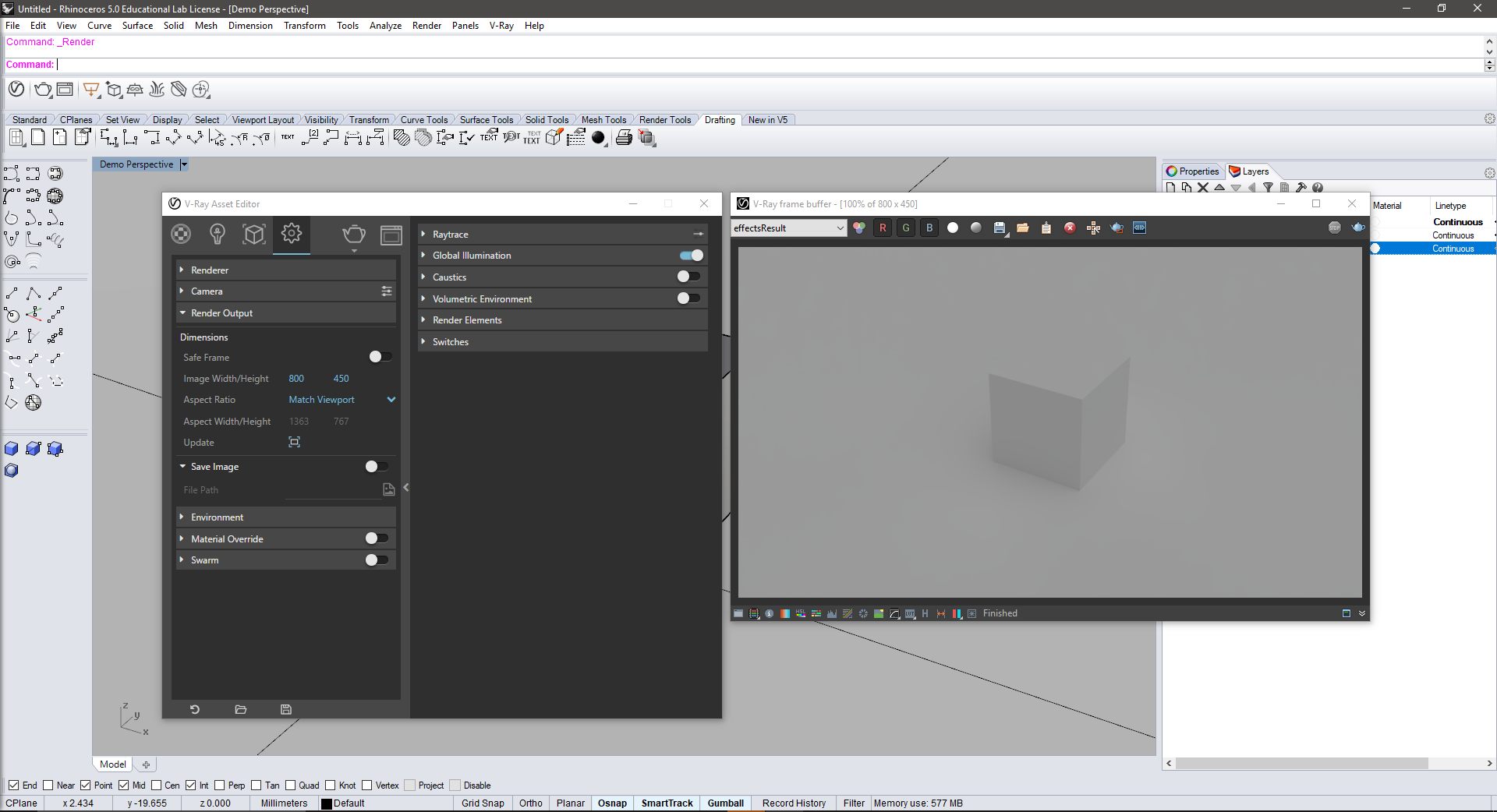
- Aspect Ratio: Here you can adjust the aspect ratio of the exported image. You can set custom ratios or use typical dimensions.
- Save Image: Here you can choose if you would like V -Ray to automatically save the rendered image once it is completed. You can select a folder, file type and name to save the file as.
- Under this menu you can control the output size of your rendered image. Remember, the bigger the image, the more pixels the computer needs to paint and the longer the process will take. For final images you should export large images to make sure the final result does not come out pixelated but for test renders, you can get away with smaller images.
———————————————————————————–
V-Ray 3.0 Materials:
- To create a material, click on the Materials icon in the Asset Editor and then click on the icon in the bottom left of the Asset Editor window.
- Create two materials and name them Box Material and Infinite Plane Material. Don’t worry about the materials’ settings yet.
- Once these materials are created, select the Box in your Rhino window and then move back to the Asset Editor window and right click on the “Box Material”. This will show a few options and you should select “Apply to Selection” which will then map the “Box material” to the box. Repeat this step but instead apply the Infinite Plane material to the Infinite Plane.
- For this demo, I want to make the box a white flat material while making the ground a gray reflective material to show the contrast between the two.
- First, let’s change the Diffuse amount of the materials. The Diffuse amount of a material is basically how much light a material will absorb and what color the material will then reflect as a result (think of how colors work; a blue shirt absorbs everything beside the color blue which it then bounces back).
- Start by moving the Diffuse slider for the Box Material all the way to the right and notice how the material sample looks like a flat white material. We can also move the Diffuse slider to the left for the Infinite Plane material and notice how the sample shows a reflection in the material.


- Now if you render the scene you will see that the box is a flat white color while the ground shows a reflection of the box.

- You can also adjust the Diffuse color of an object by clicking on the rectangle next to the Diffuse slider. You will then see the sample image turn to the color you select (Red). Render the image and the box will adjust color.

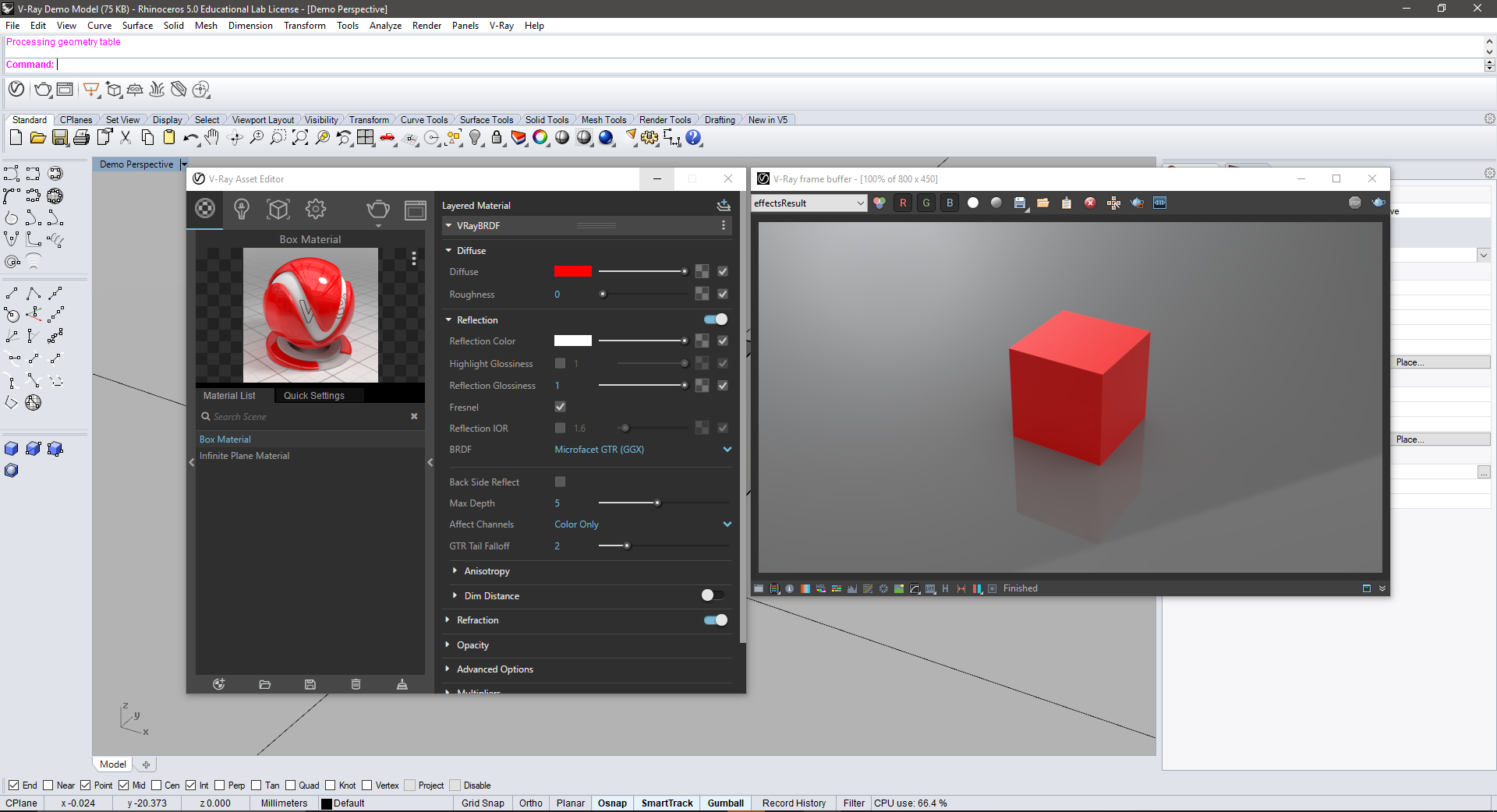
- Notice as well that the red material now has a reflective amount to it compared to the white material. To remove this, open the drop down for Reflection and move the Reflection Color slider all the way to the left. You will then see the sample image lose its reflective amount.
- Render the image and you will see that the box becomes a little flat compared to when it has a reflection amount. Almost everything has at least some reflectivity, keep that in mind when you are rendering out your projects.
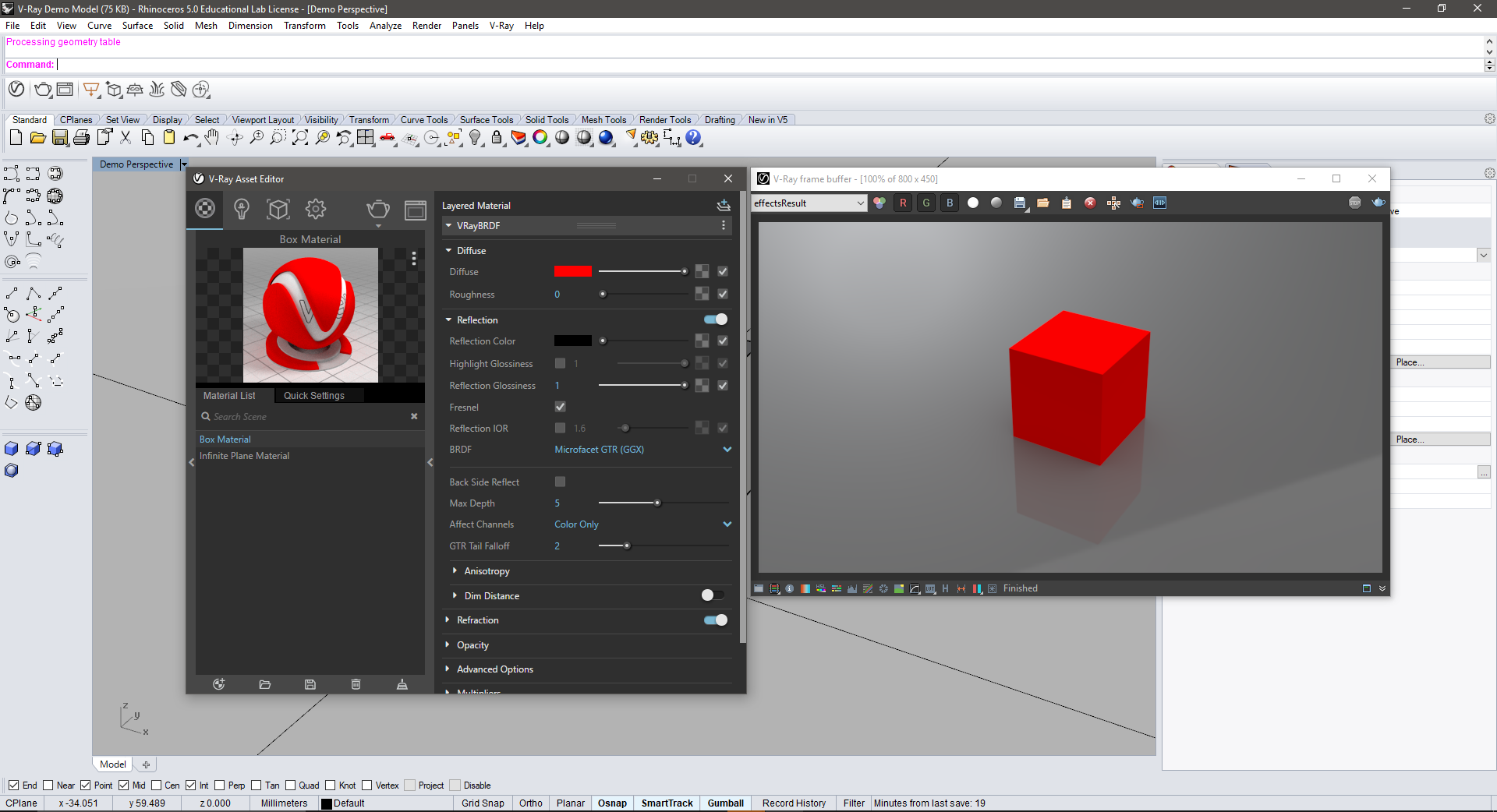
———————————————————————————–
V-Ray 3.0 Materials: Mapping Images
- You can also add materials to your objects by loading in image files. Let’s test this with an image of concrete and map it to our block.
- To do this, click on the square to the right of the Diffuse slider. Find the “Bit-Map” option.


- Clicking on Bitmap will open your File Explorer where you will find the image you want to map to the cube. After you select the concrete file, click Back and you should see the Image Sample is now updated with your mapped material. Hit Render and you should see your cube now has the image mapped to it.
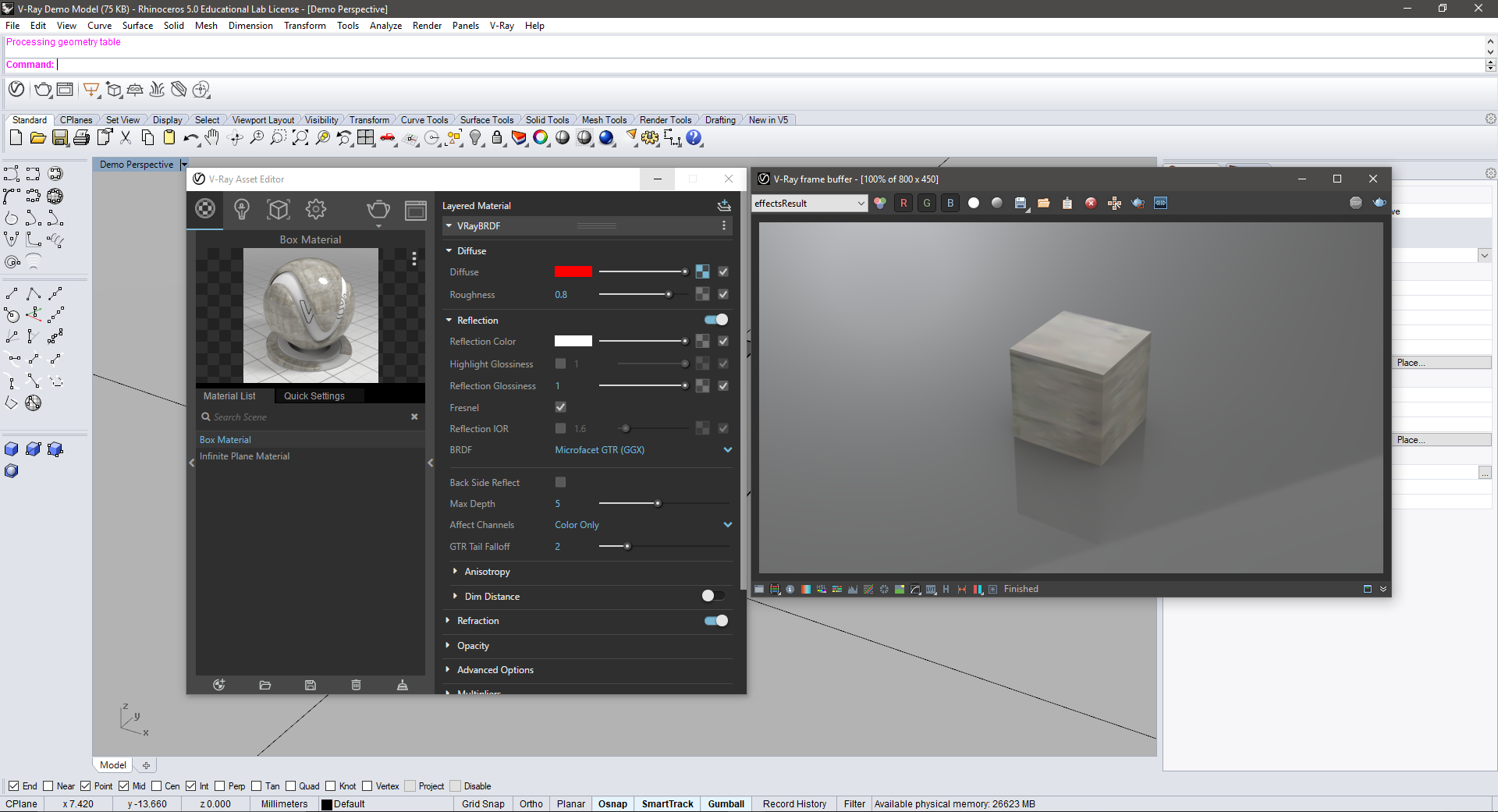
- Now there are two issues with this material as is; 1. It is too reflective for concrete, so I want to decrease that amount and 2. The texture looks too stretched and pixelated.
- First, adjust the reflective amount. Remember, we can just move the Reflection color slider to the left and the reflectivity will decrease.
- Now to adjust the size of the image map so it looks better suited to our box. First, click on the square to access the Bit Map menu again. Click on the drop-down arrow for the Texture Placement menu and locate the “Repeat U/V” option. Changing these numbers will effectively change the size of the texture. Go ahead and change the first value to 4 and the second to 2.
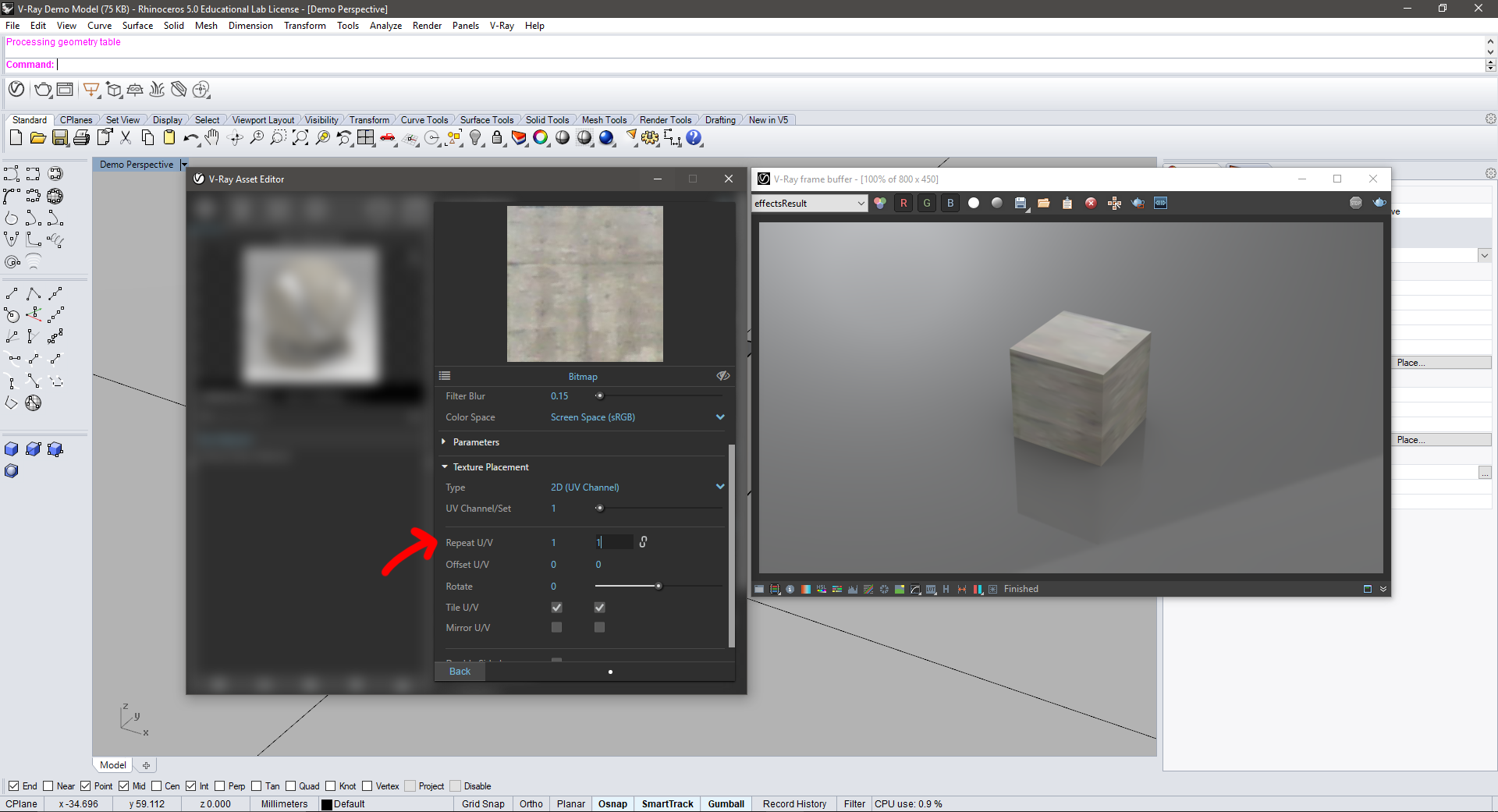
- Hit back and you should see the Image Sample adjust to the new texture size. Render the image and you should also see the texture scale on the Box. Now the box looks a little more like panelized concrete. Continue this process of adjusting until appropriate.
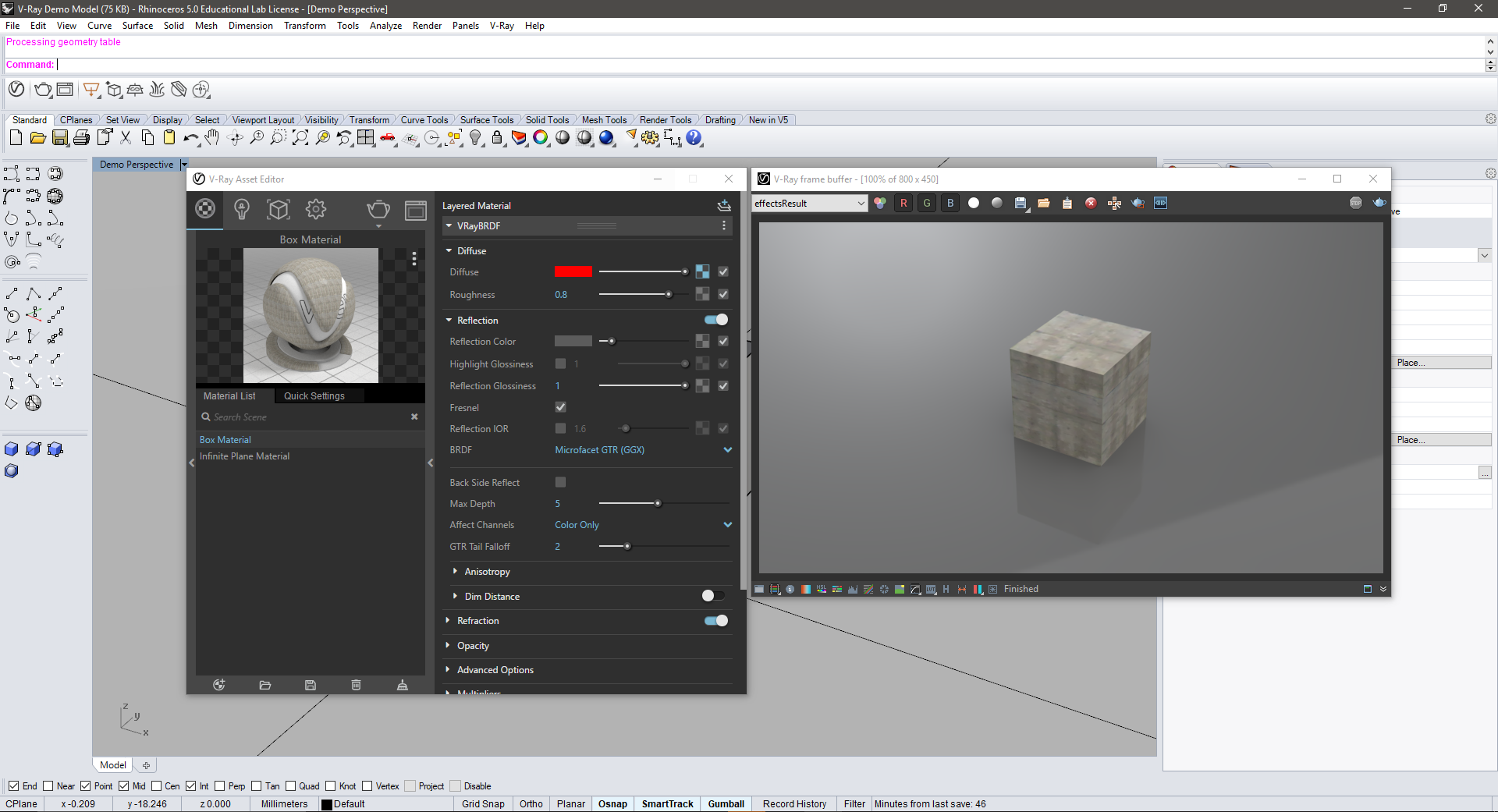
- Note: Notice that the Diffuse Color is still red but the box doesn’t look red. This is because the image you mapped to the box is overriding the red color.
———————————————————————————–
V-Ray 3.0 Lights
- For lighting in V-Ray, there are a few different lights we can use for our scenes but we will focus on a few; the document light, a rectangle light and the Sun light.
Global Illumination (G.I.):
- So far, we have been rendering with just Global Illumination active. GI creates a soft and even lighting condition across the entire model (notice how there are no shadows on the model because the light is coming from everywhere not a single point like a sun). GI is great for quick studies or product design models which dont need harsh shadows. However, for architecture, sometimes crisp shadow lines are really beneficial to a model.
- Global Illumination is active by default but can be toggled on and off through the extended menu of the Settings submenu.
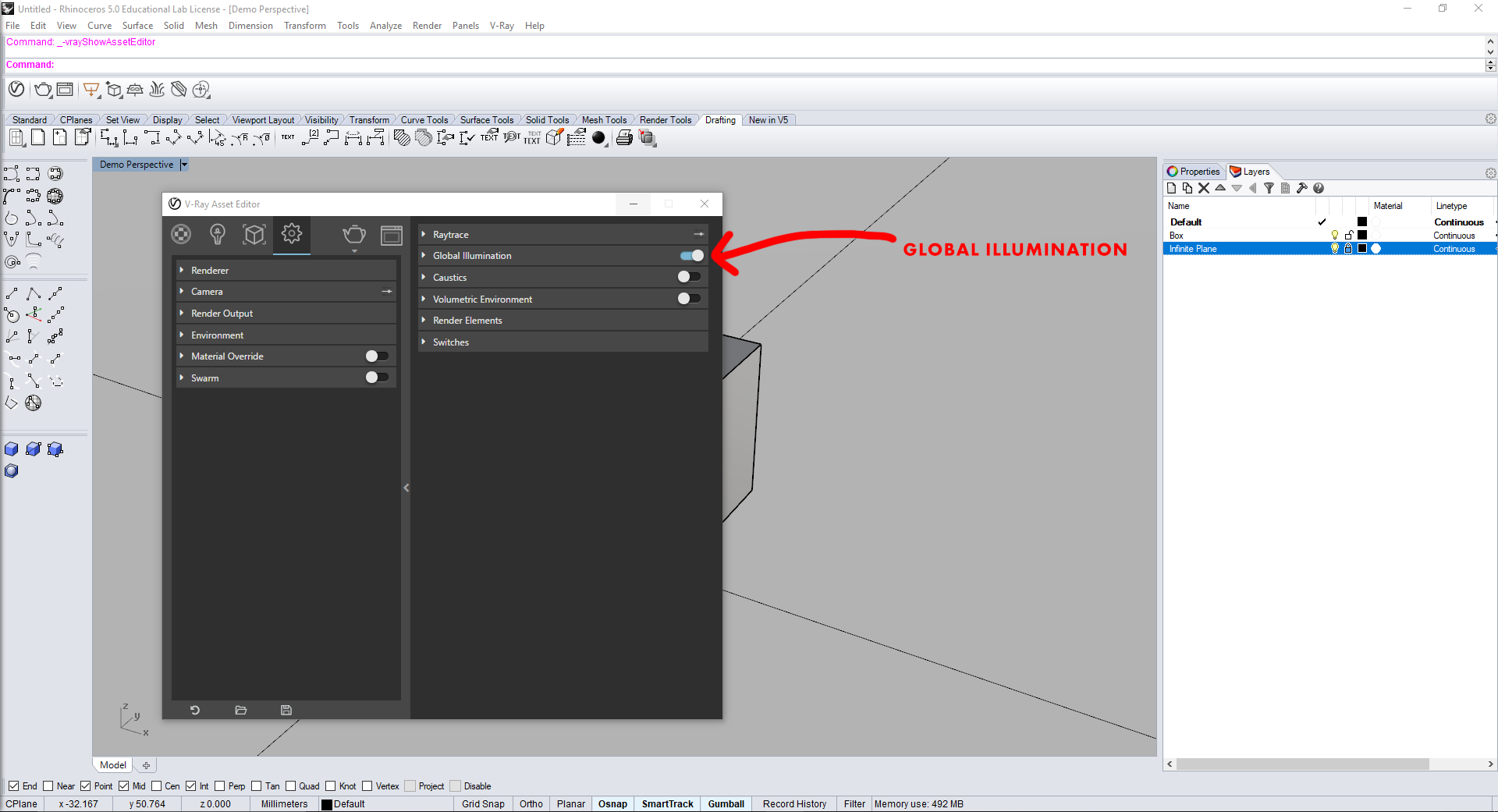
Rhino Document Sun:
- To turn on the Rhino Document Sun, click the Lights icon and then select the Rhino Document Light. This will show options to the right of the lights list and will also show a switch in the top right corner. Click this switch to turn on the Rhino Document Light. Render the scene and hide your eyes as it should be WAY too bright for our box.
- To create a more useful lighting from this Sun, change the Intensity Multiplier from 1 to something between 0.05-0.2. This will scale down the strength of the sun to something more compatible with our scene.
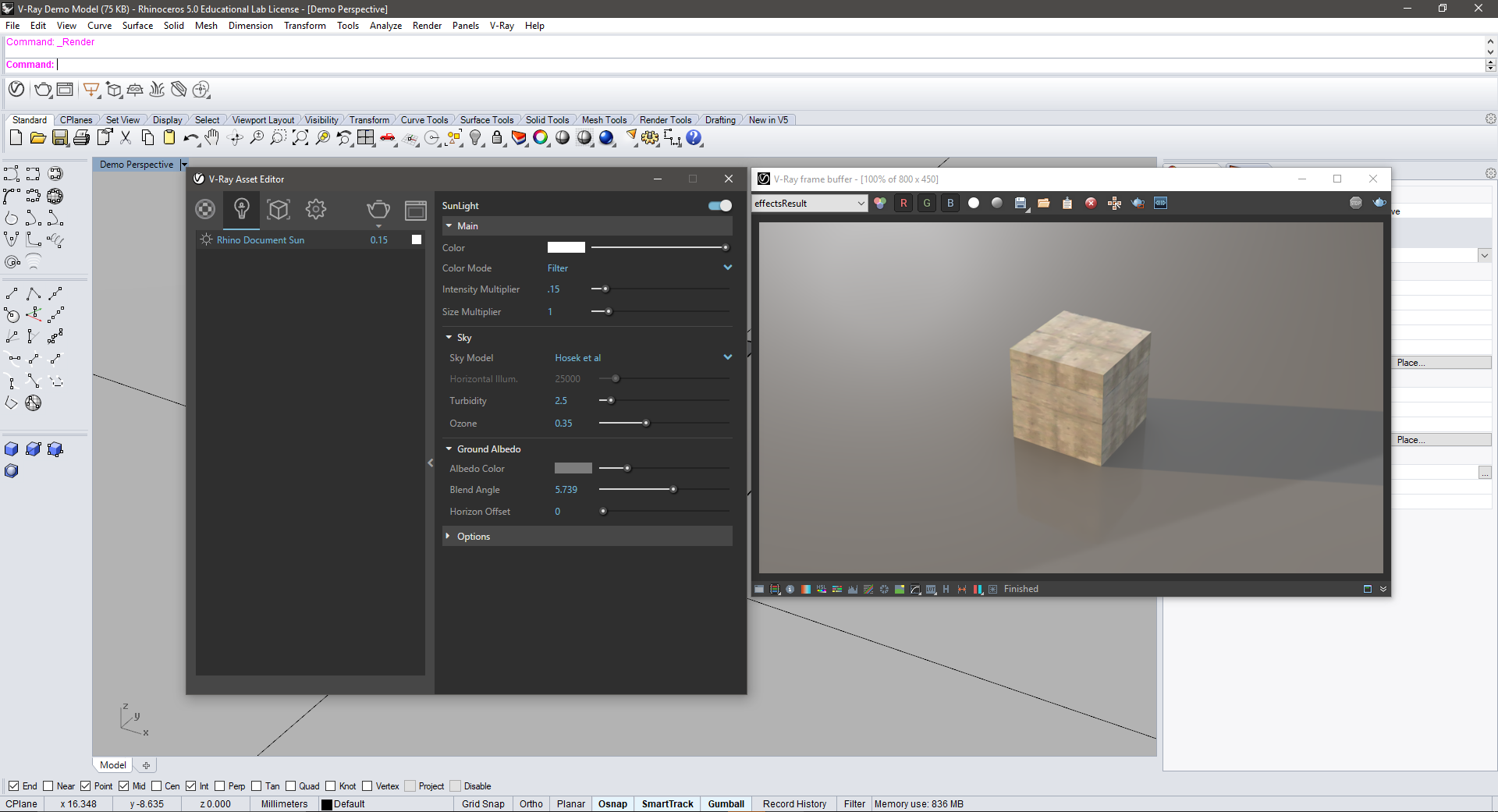
Sun Light
- To create this light go to the V-Ray menu in Rhino and navigate to V-Ray Lights. Click on Sun Light and a new window will pop-up. (This is a different sun than rhino sun.)
- In this menu, you can set what time of year your “sun” is at. If you deselect the “Manual Control” button in the top left, you can then move the sliders for the time of year and time of day to control the settings of your sun. Click ok and then the menu will close and bring you back to Rhino where you will click to place your sun.
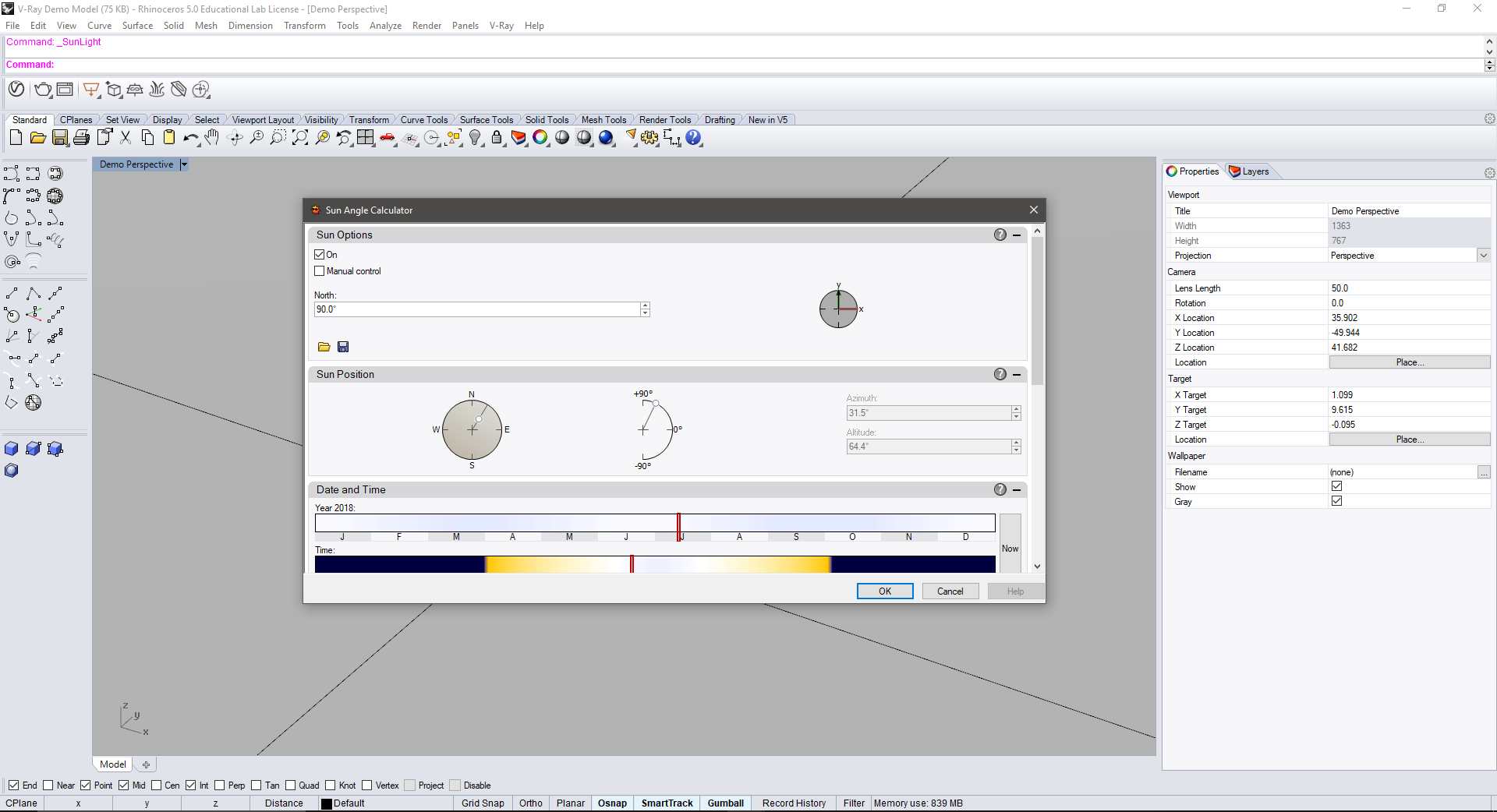
- You can move the sun around in Rhino until you’re happy with its locations. Make sure to move the Sun to its own layer to maintain the cleanliness of your scene.
- Re-open the Asset Editor and Frame Buffer and open the Lights menu in the Asset Editor. Turn off the Document Sun and then turn on the Sun Light. Adjust the intensity of the Sun Light to match the scene. Again, something between 0.05 -0.20 will work best.
- Re-render the scene and notice the differences in the Sun Light compared to the Document Sun. The biggest difference is your ability to move the Sun Light around in the scene to explore different lighting angles. Test a few renders while moving the sun around.
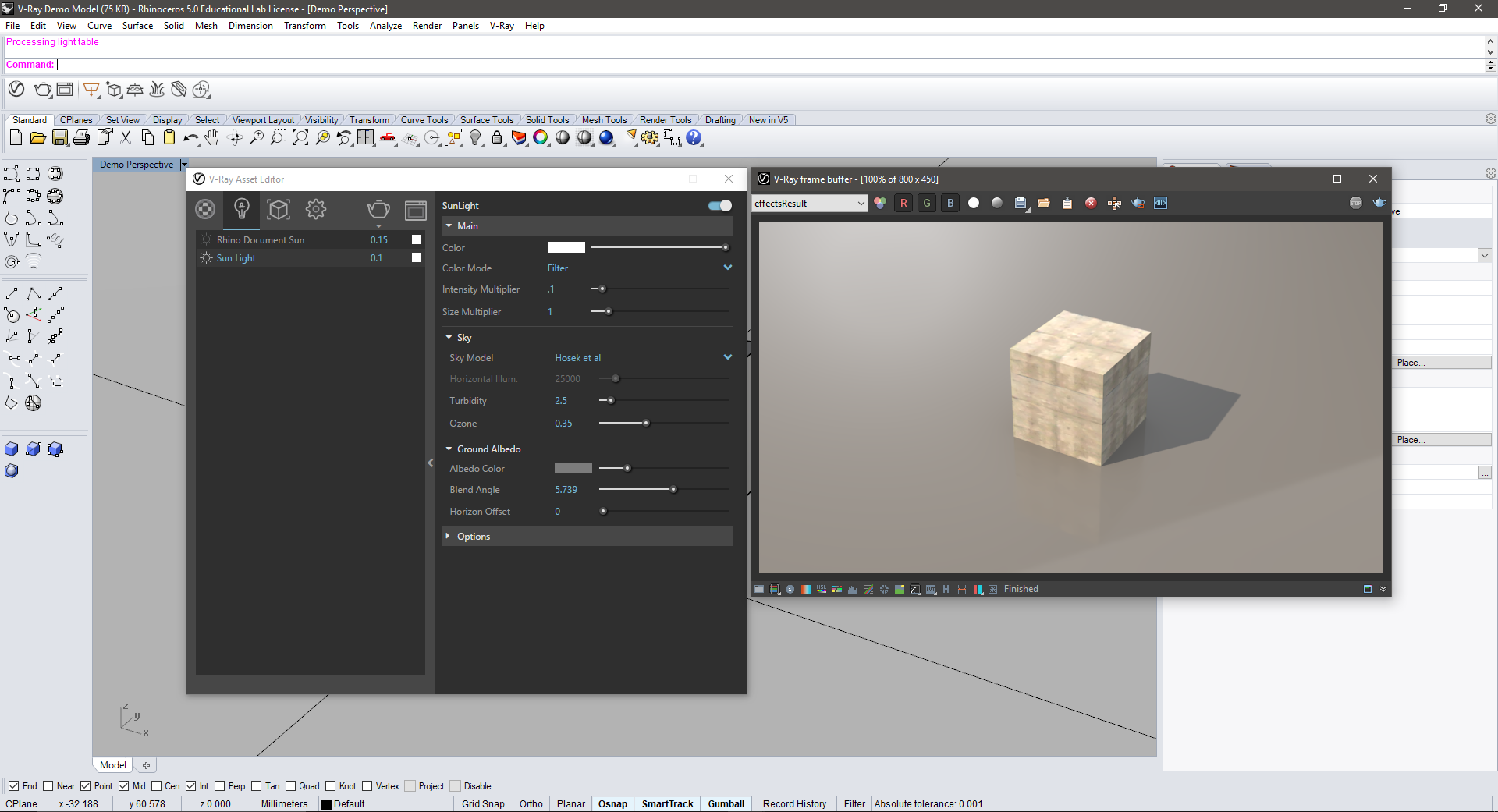
Rectangle Light
- The Rectangle Light can be used to light interior scenes or used for studio lighting similar to product or model shots.
- To create a Rectangle Light, navigate to the V-Ray Lights menu in Rhino and select the Rectangle Light. You will then click in the Rhino window and draw a line which indicates the width of the light. Then, you will drag out a rectangle to create the length of the light.
- Drag it up above your box in rhino. Turn off both the Sun Light and Document Light and render the scene. You will notice that it does not look too different then the basic Global Illumination scene we started with. This is because, the Rectangle Light needs to be scaled up in intensity to light the scene.
- Click on the Rectangle light in the Asset Editor menu and navigate to the Intensity slider. Here you can enter a larger value for the light. Start somewhere between 100-300. Re-render the scene and you should now see the effect of the light.
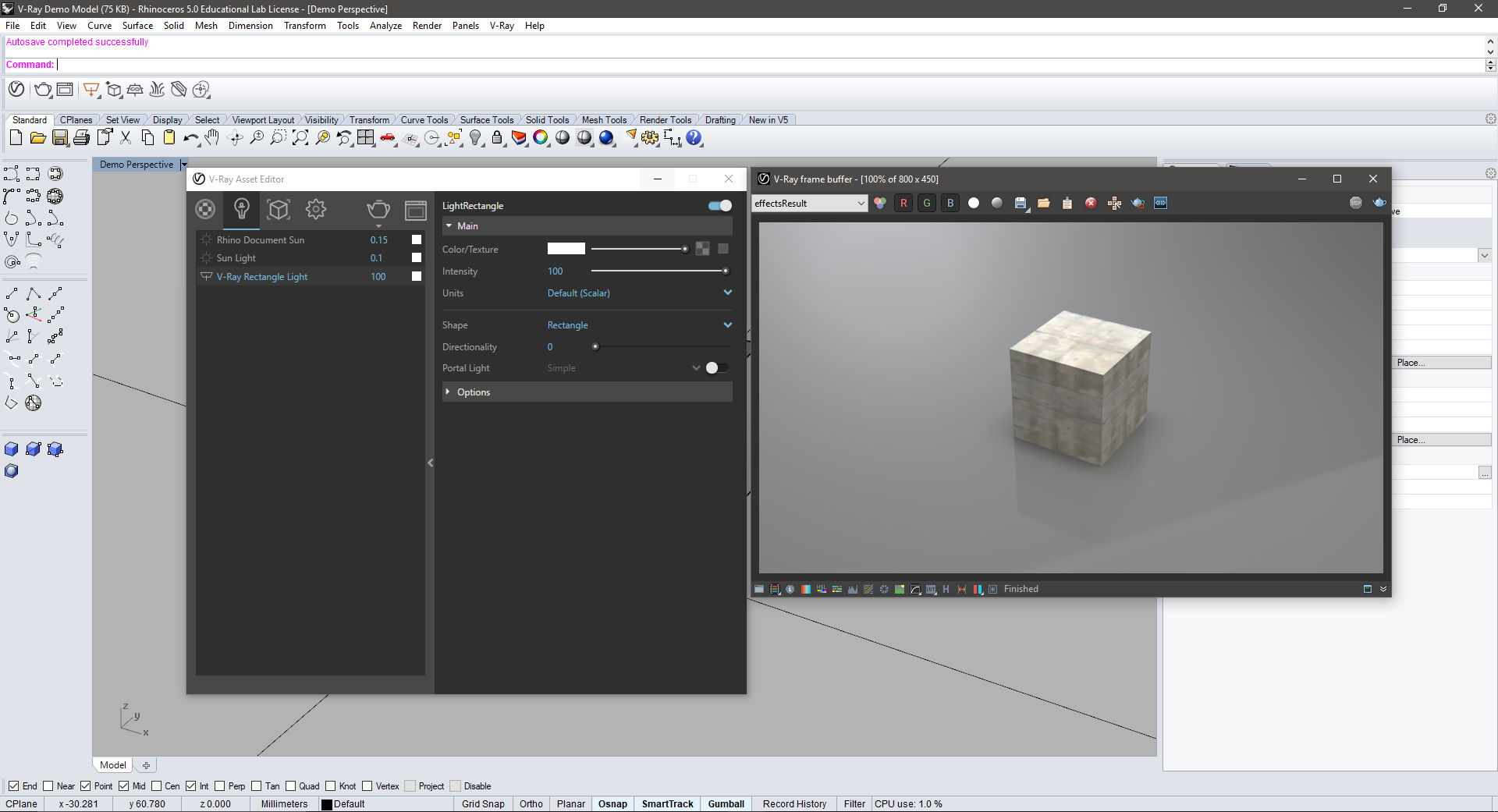
References for Visualization Firms, Materials and Lighting Techniques:
- Creating great renderings takes a balance of technical skill and an artistic eye. Below are some references to look through to learn from their work, techniques and resources.
- The best thing you can do to learn V-Ray in depth is to continue to experiment and test ideas so that you can learn how things work. Break stuff, turn it upside down and learn how to do the basics along the way.
Architectural Visualization References:
- MIR | mir.no
- Arqui9 | https://www.arqui9.com/
- Brick Visualization | http://brickvisual.com/
- Luxigon | http://www.luxigon.com/
- Visualizing Architecture | https://visualizingarchitecture.com/
Technique Books:
-
Light for Visual Artists: Understanding & Using Light in Art & Design | https://www.amazon.com/Light-Visual-Artists-Understanding-Design/dp/185669660X
Youtube:
- Show It Better | https://www.youtube.com/channel/UC_eRv_Rzr671BaKFtpYSi4A





